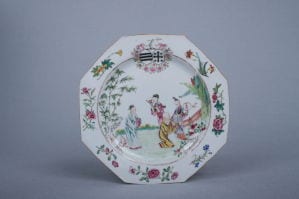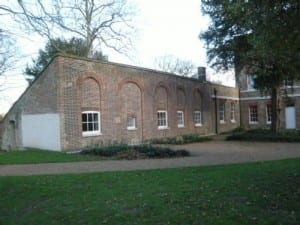
Plate decorated with the arms of Charles Raymond and his wife, Sarah Webster. China, c.1760, Porcelain. Private collection. Image courtesy of Georgina Green. As this section of the case study reveals wealth, good connections and a sense of fashion allowed captains such as Sir Charles Raymond to acquire luxury, personalised items such as this. Image courtesy of Georgina Green.
During the eighteenth century three owners of Valentines were involved with the East India Company (EIC): Robert Surman, Sir Charles Raymond and Donald Cameron. Robert Surman, Deputy Cashier of the South Sea Company in 1720, spent a short time in prison when the ‘Bubble’ burst but survived with £5000 and purchased Valentines in 1724. He does not appear to have been unduly tainted by the ‘South Sea Bubble’ and returned to banking, becoming a partner in Martin’s Bank and later founding his own bank, Surman, Dineley and Cliffe. He invested in the EIC, managing the ship Sandwich. In 1754 he sold the house to Charles Raymond, a retired EIC captain who managed many voyages for the EIC and became a very respected figure in the City.

Portrait of Sir Charles Raymond. Reproduced by kind permission of The Royal Bank of Scotland Group Copyright 2012.
Raymond was a successful captain whose profitable voyages in the Company’s service played a key role in his emergence as a man of wealth and fortune. Much of the Company’s profit derived from the private trade goods brought home by the captains and officers of East Indiamen. On his second voyage as captain of the Wager 1737/8 (i.e. she left England in the winter of 1737/8), for example, Charles Raymond earned £3,100 in this way. However while his ship was being prepared for the return journey he was free to work with local agents and he deposited rupees with the East India Company’s accountant in Bengal for which he was later paid £3,000 in London. So his earnings in trading privately earned him at least 30 times the salary paid to him as the captain (approx £200). To learn more about Raymond’s salary and earnings, click here.
Sir Charles Raymond was Valentines’ most important link with the EIC and the material goods from Asia which so decisively shaped Georgian domestic interiors. Valentines is not a grand house, but it was nonetheless a family home which boasted many exotic, luxurious objects. It is important as a lonely survivor in East London of the type of home described by Sylas Neville in 1785 as ‘the small but neat box of the retired East India captain.’ The Sun Fire Office insurance documents illustrate the increase in value of the contents of Valentine House during Raymond’s occupancy (1754-78). The value of insured goods rose from £500 in 1755 with the household goods insurance tripling to £1,500 in 1769, with an additional £500 for china and glass. (In spite of the restoration and refurbishment, the actual building insurance remained the same).
Domestic luxury goods produced in Britain figured among Sir Charles Raymond’s purchases for Valentines: during Raymond’s tenure, the original of Hogarth’s ‘Southwark Fair’ was at Valentines, probably one of several works of art in which Raymond invested his fortune. But goods from the Orient were especially conspicuous among the material objects recorded as belonging to Valentines during Raymond’s day. A porcelain plate made for Raymond in China (seen above), with his arms is again displayed in the house: it seems he had large dinner and tea services made in China. Other items of a similar nature have come up at auction.

Plate, Jingdezhen, 1580-1610, Porcelain, C.588-1922, Victoria & Albert Museum. This example of Jingdezhen porcelain gives an impression of the vibrancy of goods that EIC captains traded. To learn more about Jingdezhen and the porcelain trade visit Warwick University’s Global Jingdezhen: Local Manufacturers and Early Modern Global Connections research project website.
Another interesting item which has been traced to Company trade is a book presented to Raymond by Captain Josiah Hindman. He served as first mate when Raymond was captain of the Wager and went on to captain the ship when Raymond retired and became the principal managing owner. The book was hand painted in China, larger than A3 landscape, and bound in leather. It has a series of 814 watercolour illustrations of plants and insects found in China, with Chinese and English captions detailing medical use. It is now in Royal College of Physicians Library in London.
In 1771 it was said that Valentines ‘may, with great propriety, be called a Cabinet of Curiosities’, suggesting Raymond had a collection of strange items he had brought home on his travels. We know he gave a neighbour a piece of sculpture of a hard, dark marble which had been brought home from the Island of Elephanta. Contact with divers who have investigated the site of the wreck of Sir Charles Raymond’s East Indiaman Valentine (discussed in Shipwrecks and the East India’s ‘Immaterial’ Material Culture) has provided another exciting insight into life at Valentines in the Georgian era, connecting Raymond’s home to the Company’s trade in exotic ‘Oriental’ luxuries that included the blue and white porcelain produced in China at Jingdezhen (see picture right for example of the type of porcelain produced in Jingdezhen) as well as vibrant Indian dyes used to produce cotton textiles such as fashionable chintz.
In 1769 Raymond made significant changes to Valentine House, adding a bay and raising the roof. In 1771 the building was described as ‘one of the neatest, and best adapted of its size, of any modern one in the county; its ornaments are well chosen, and the grounds belonging to it laid out with great judgement and taste.’ The external appearance of Valentines today is much as it was at that time. Raymond enhanced the gardens which had been created by Surman. In 1758 he planted a black Hamburg vine which became very prolific. A cutting was taken to Hampton Court Palace and has achieved greater fame than the parent plant which died late in the nineteenth century.

Valentines featured in A New and Complete History of Essex by a Gentleman (1771). The image of Valentines it included is featured here (above) to show the position of the Orangery (to the left of the house) and the prominence of the gardens and grounds. The image below right shows the dairy wing, converted from the orangery in around 1808.
Both Robert Surman and Charles Raymond came to live at Valentines when they had small daughters, and it is not hard to imagine the girls growing up, playing games when small and walking in the gardens as they grew older. In Raymond’s time there was a conservatory or orangery beside the house (converted into the dairy wing c.1808) which would have given them an elegant but sheltered place on colder days. This could well have housed plants brought home from the East. Like the Oriental luxuries with which wealthy Georgians furnished their domestic interiors, gifts of exotic flora and fauna were integral components of the material exchanges that oiled the wheels of the Company’s patronage and helped maintain close ties among members of the Company’s far-flung family networks.
Imports from the East adorned not only Valentines’ interiors but also its gardens. A letter from George Edwards, FRS, was read to the Royal Society on 17 January 1771, in which he mentioned seeing ‘some curious birds and other animals, from the East Indies’ when he visited Valentine House ‘last August’. Edwards described a new species of bird which he called a ‘snake-eater’ but is known today as a secretary bird. His letter says that a pair of birds was brought home but one died soon after it was landed. From the description given by Raymond’s servant, it was thought to be a male of the species. The birds must have been caught when an East Indiaman (possibly the Granby) called in at the Cape (South Africa) on the way home.
When Charles Raymond died in 1788 he left a lengthy, legalistic will. He ensured his eldest grandson would be provided for, and he left a small amount to his sister-in-law Elizabeth Webber, but otherwise his property was to be divided between his two surviving daughters, Sophia Burrell and Juliana Boulton. Raymond’s eldest daughter, Lady Sophia Burrell, became known as a writer and poetess. She married William Burrell, grandson of Charles Raymond’s uncle, Hugh Raymond, who has served as EIC captain and later PMO early in the 18th century. It was Hugh Raymond who ensured Charles had a good introduction to the sea and who built the Wager for him in 1734. In default of male issue, William Burrell was named to inherit the baronetcy granted to Charles Raymond on 4 May 1774.
Sophia’s two younger sisters both married men closely connected with their father through the EIC. The youngest, Anna Maria, married Thomas Newte who was also a second cousin but through Charles Raymond’s mother. He had come up through the ranks of the EIC to become captain and later PMO, working in close association with the Raymond family. Sadly Anna Maria died in 1781, two years after they were married. Juliana, the middle daughter, married Henry (Crabb) Boulton, the son of Richard Crabb who had sailed alongside Charles Raymond as a fellow captain and who also became a PMO. Richard’s brother Henry Crabb had served as a senior clerk with EIC and later became a director. Both brothers took the name Boulton from their cousin Richard Boulton who was connected to EIC for 40 years, and left property to Henry which later passed to his brother Richard.
On Raymond’s death, Valentines and many of its contents were sold to the third of its Georgian owners with EIC connections, Donald Cameron. He came from an ancient Scottish family and in 1763 married Mary Guy, a step-sister of Charles Raymond’s wife. By 1778 he was working at the banking house of Sir Charles Raymond and Co. where he later became a partner. He took over the management of several East Indiamen in association with Charles Raymond. Cameron had been living at a property owned by Raymond, immediately to the south of the Valentines estate, later known as Ilford Lodge. In 1791 Cameron served as Sheriff of Essex but by the time he died in 1797 the bank had suffered serious losses due to the French revolution and Valentines and its contents were sold with other property he owned in Ilford to meet the debts (see left). The details of the sale included paintings by eminent masters, prints and drawings, oriental articles and fine ornamental china, a library of books and a considerable quantity of fine wines. As the advertisement for the auction in the St James’s Chronicle attests, by the later eighteenth century, Asian luxuries were fully integrated with English objects d’art in the homes of Company families in Ilford.
